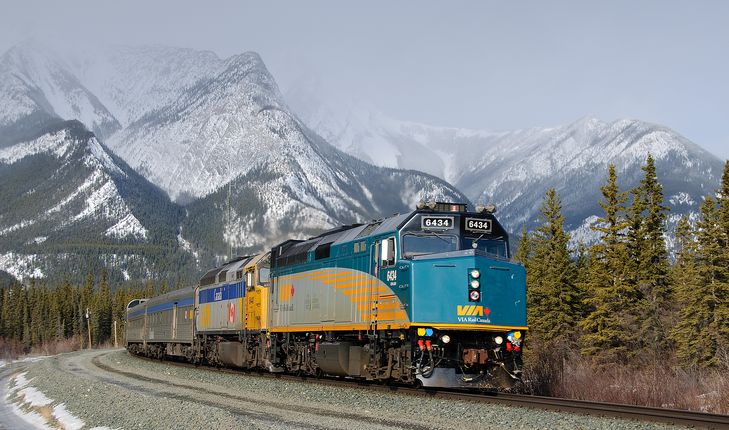In 1967 the Boxtops sang “Give me a ticket for an aeroplane, ain’t got time to take a fast train.” 53 years later in the Canada of COVID-19, the chances of going anywhere, whether by plane or train or even long-distance bus, are severely limited. Even before COVID, Canada’s transportation system between towns and cities was not fast, affordable or reliable. The root of Canada’s transport problems lies with a combination of privatization, deregulated private enterprise, and governments pursuing austerity policies in relation to the industry that it is supposed to control.
Come fly with me – by Air Canada if you must
Canada’s national airline was established as a public corporation in 1937. In 1965 Trans Canada Airlines was renamed Air Canada (AC). After the deregulation of the Canadian airline market in the 1980s, the airline was privatized in 1988. Prior to privatization, AC’s domestic flights covered a lot more than the busy inter-city routes (Montreal –Toronto – Vancouver – Edmonton, etc.). They also included flights to far less densely populated towns and cities such as North Bay to Toronto and Halifax to Charlottetown.
In early July 2020, AC suspended indefinitely 30 of its routes, citing COVID as the reason but making it clear, by also shuttering operations entirely at some airports, that they were unlikely to be resumed. 22 of the 30 suspended routes lie in Atlantic Canada and Québec. As journalist Thomas Walkom wrote, “It is not at all clear that the communities affected, such as Bathurst, N.B. or Val d’Or Que., will have much to fall back on once AC pulls out. In that sense, AC is running afoul of the implicit understanding made 31 years ago when the crown corporation was allowed to go private. While never spelled out, the political understanding then was that AC would not abandon smaller communities entirely in its quest for profits.”
Even before the announcement of the suspended routes, AC was already lobbying the government for a bailout that would allow it to ride out the pandemic. We’ve been here before. After the 9/11 attacks, the carrier received $100 million from Ottawa. In 2009, AC pushed for, and got, a government commitment for financial relief in the form of lower obligatory payments to its underfunded pension plan. When times were good and profits high, AC used them to buy back shares – boosting executive’s income. Since 2015, Air Canada has spent more than $800 million in share buybacks.
What concessions AC extracts this time around are anyone’s guess. One thing is certain: with losses topping $1 billion in the latest quarter, AC needs help, and fast. Airlines have already tapped into Ottawa’s emergency wage subsidy, and they could be eligible for more. Some argue that, in return for help, the government should extract concessions from AC: capping executive pay, axing hefty bonuses and eliminating stock buybacks. Not bad ideas but they don’t address the structural issues and AC will be left intact as a private capitalist outfit that will seek another bailout when the next crisis hits.
Deregulation and privatization were the building blocks of the neoliberal agenda of the 1980s and 1990s. “They were supposed to provide those travelling by bus, train or plane with plenty of choice. They were supposed to provide high quality at low cost. But they didn’t. Even before the pandemic, air travel was a nightmare, characterized by long waits and impossibly uncomfortable seats.”
The airline industry wasn’t exactly a model of customer service during the first few months of the pandemic. If they cancelled the flight, you got a refund in some cases but if you cancelled, you’d have to accept a voucher to be redeemed within two years. After public pressure, this was changed to a transfer with no expiry date. And when it came to resumption of flights, during the easing of the lockdown, what precautions were to be in place? Masks and PPE were mandated, but AC and others insisted that social distancing –leaving a good portion of seats empty – was impossible if they were to make a profit. And what is more important than their profit?
Gonna catch a fast train?
If you can’t fly and don’t have a car, in theory, the next fastest way is by train. In 1977, VIA Rail was established as a separate Crown corporation, a spin off from CN (Canadian National Railway). It receives a subsidy from Transport Canada to provide service to remote communities. 40 years ago, Canadians were told by politicians that privatization was the start of a rail renaissance. In fact, it was just a method for cutting the partial and totally inadequate 80 percent subsidy to CP and CN to run the service-worn trains inherited from them. Moreover, they were compelled to operate in the face of massive subsidies to air and highway travel.
Via remains an independent federal Crown corporation mandated to operate as a business, but still it is vulnerable to federal budget cuts. It has suffered a history of having to serve as a political football for whichever party was in power in Ottawa. The first of a long line of cuts occurred on the very day Via took over the western trains from CP and CN when pieces of the routes were immediately dropped under that usual term for cuts, “rationalization.” Further and larger cuts would occur under the Liberals and the Conservatives, both of which had previously made grand election promises of Via investment, renewal and service expansion. Despite never receiving consistent funding, Via still operates more than 500 trains per week from coast to coast. Over five million passenger voyages were taken in 2019, a record.
Canadian railways were built and run with public money. The owners of the Canadian Pacific Railway received huge bribes of land and money to build it. Canadian National Railway was formed in 1918 when several failed railways were taken into public ownership and merged with publicly built lines. CN was privatized in 1995.
The BC government built a railway, for freight and passengers, from Vancouver to Prince George and into northern B.C. In 2004, amidst a lot of scandal, BC Rail was sold to CN.
Churchill, Manitoba’s only land connection to the rest of Canada is by rail. CN sold the track in 1997 to OmniTRAX. Due to lack of maintenance, the track was damaged and closed in 2017, cutting Churchill off with serious economic and social impacts. Eventually, Arctic Gateway Group (half owned by First Nations and government) bought the track, received federal support money, repaired the track and Churchill was re-connected.
Customer service, profit and socialist planning
When it comes to the train, less than 20 years ago, intercity commuters could catch an express Via train from downtown Toronto at 5 pm and arrive in downtown Montreal in four hours. In 2020, the same trip takes up to five hours. That is after the federal government invested more than $300 million over the past decade to improve the service. A train from Vancouver to Toronto takes 12 hours longer than the same journey did in 1952.
Via isn’t entirely to blame for these results. Its passenger trains are using railway tracks that Via doesn’t own. CN owns most of these tracks, which requires Via to negotiate agreements on access and scheduling with CN, without guarantees that the passenger trains will have the timely access needed to keep trips on time. So, one public railway entity (Via) is now fighting it out with a former public one (CN) on the question of property rights and access. What a glaring condemnation of the “mixed economy” or state capitalism, what a convincing case for the need for socialist integrated planning.
And the bus? – the wheels go round and round all through the town
In 2018, Greyhound Canada announced it was shutting down passenger and delivery services on the Prairies, northwestern Ontario and all but one cross-border route in British Columbia. This May, citing the pandemic, Greyhound suspended all bus service in the rest of Canada, leaving those who either don’t have or can’t afford a car few options besides costlier train and airplane tickets or begging rides from friends.
In itself, access to a bus isn’t a human right but it is linked to other rights – if you are unable to get around to access services like women’s shelters, abortion services, even jobs, then your rights are being undermined. The Highway of Tears, between Prince Rupert and Prince George in northern BC, is where many women have been murdered, often while hitch-hiking.
Greyhound isn’t alone in its problems. The publicly owned Saskatchewan Transportation Company was founded in 1946. It served some 250 destinations in the province. TheSaskatchewan Party government closed it all in 2017. The bus industry has been shrinking due to increased car ownership and declining rural populations. There were 13 intercity and rural bus companies in 2015, half as many as in 2008. Most of these companies are provincially run Crown corporations. And the sector lost money in all but two of the years over that period.
As recently as the early 1990s, virtually every city in Ontario was served by at least one daily intercity bus connection. Many of those routes have been cut in the decades since, leaving dozens of communities without bus service of any kind. On the densely populated Windsor to Québec City corridor there are options of air, rail, bus and various shuttles.
As small remote communities shrink, communities within the orbits of Canada’s largest cities are growing. Cities that surround large urban centres – so-called “peripheral municipalities” – grew significantly faster than the country’s largest cities between 2011 and 2016. However, commuters, driven out of the big cities by expensive housing, mostly have to use cars.
A recent poll suggests the majority of Canadians are in favour of the federal government funding a rural bus service. The Angus Reid study was conducted after Greyhound Canada announced it was shutting down all services west of Thunder Bay. 60 percent of those who participated in the poll said they would support a rural bus service funded by the federal government, and 64 percent said they would be in favour of a provincially funded service. The study also asked Canadians which of two statements was closest to their point of view: “Government should step in to maintain rural and northern bus services, they are vital to communities,” or: “It should not be up to government to maintain these services, private businesses can fill the gaps if there is enough demand.” 56 percent of respondents voted in favour of the first statement, while 44 percent selected the second.
Freight
Most freight in Canada is moved by rail, overwhelmingly by CN and CP. However, much of the track is poorly maintained, due to lax legislation that allows the companies to largely do their own inspections, and cost cutting. On average there are 50 derailments a month; though most are not fatal or dangerous, some are.
Two trains, both carrying crude oil, derailed within two months in 2019-20 on flat straight track, a few kilometres apart, in Saskatchewan, both causing major fires and oil spills.
Three workers were killed in a train derailment in the Rockies, in 2019, due to failed brakes. Evidently trains brakes are ineffective in cold weather – not uncommon in Canadian winters! Five rail workers were killed on the job in 2019.
Poor track quality also means freight trains move slowly and cause delays to passenger trains.
The case for a socialist integrated transport system – climate change
Public funds built most of Canada’s transportation network. Railways were either directly constructed by governments or huge bribes were paid to the private owners. The highway network was built and is maintained by public funds. Much of the foundations of Air Canada were built by public money. Now rail and air are privately owned and run for profit rather than convenience, while public roads provide massive hidden subsidies to trucking.
The case for an integrated publicly owned transport system isn’t just based on equity and efficiency. Another compelling reason is climate change. The rapid expansion of air and road (cars and trucks) transportation over the last 60 years has produced a massive growth in CO2 emissions. The transport sector accounts for some 30 percent of total global emissions. The table below indicates the extent of the problem, showing the culpability of the airline and road sectors. Socialist Alternative doesn’t have an agenda of “war on the car” – many working-class people rely on cars for getting to work and taking their families to school and recreational activities.
However, our priority is to develop mass transportation. In the cities, this would mean expanding dedicated bicycle lanes, providing more bus and rapid transit services, running at greater frequency. To encourage ridership, to get people out of their cars, and to tackle urban poverty, we would introduce a free service.
For smaller towns and cities that have lost their local train, bus and air services, we would reinstate the services after having consulted with the local communities. Overall, this program should lead to substantial reductions in emissions. Where roads need to be built, it will happen in the public realm – no more P3s (public-private partnerships) that have been common in the transportation sector in Canada, where private companies sign up for sweetheart contracts and then charge user fees for years.
But it’s not just about who runs the services and how they are run. It’s also about the production of the planes, trains and buses. Bloomberg news reported in January that Montreal based company, Bombardier, “is destined to become a shell of its former self as the ailing plane and train maker struggles with liquidity.” Bombardier is a company with a history of taking its begging bowl to Ottawa. It also has a record of late deliveries of streetcars and subway trains to Canadian municipalities. We say no more bailouts, nationalise Bombardier and integrate its operations with the services provided by Via, AC and others. There’s an old saying, “you can’t control what you don’t own. And you can’t plan what you don’t control.” Another prime candidate for nationalisation would be the auto industry – not to continue with a more efficient manufacture of gas guzzling cars and vans, but to retrofit the factories of GM, Ford and Chrysler so that they become part of a Green New Deal making electric cars, buses and other socially useful products.
Socialist Alternative says:
- Public transport is not for profit. It is a public service in the interest of commuters and residents. Giving communities access to adequate public transport also reduces private car use, which reduces carbon emissions. Governments must seek to provide the most modern, low carbon impacting and most far-reaching public transport possible.
- Re-nationalise all privatised public transport and rail freight including Air Canada and CN.
- Nationalise all bus routes and bus companies.
- Nationalise the big auto companies to retrofit their factories for green production of cars, vans, and buses.
- End public-private partnerships.
- Free public transport in all urban, regional and rural areas.
The fat cats who own most of the private companies should not be compensated. The public build and subsidised much of the transport sector. Compensation should only be paid to those who would face real financial hardship.
Public transport must be run by boards elected at a municipal, regional or national level from among public transport workers, commuters and residents, with full power to approve or reject all management and planning decisions. Members of such boards to be accountable and recallable by their constituencies at any time.




